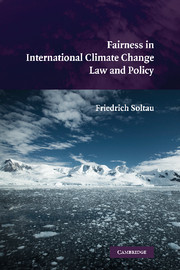Book contents
- Frontmatter
- Contents
- List of Abbreviations and Acronyms
- Acknowledgments
- 1 Fairness in International Climate Law and Policy
- 2 The Science of Climate Change and the Energy Challenge
- 3 Development of the International Climate Change Regime
- 4 Theoretical Aspects of Fairness
- 5 Fairness in the Climate Change Regime
- 6 Evaluation of Proposals for Future Climate Policy
- 7 Conclusion
- Bibliography
- Index
- References
3 - Development of the International Climate Change Regime
Published online by Cambridge University Press: 24 December 2009
- Frontmatter
- Contents
- List of Abbreviations and Acronyms
- Acknowledgments
- 1 Fairness in International Climate Law and Policy
- 2 The Science of Climate Change and the Energy Challenge
- 3 Development of the International Climate Change Regime
- 4 Theoretical Aspects of Fairness
- 5 Fairness in the Climate Change Regime
- 6 Evaluation of Proposals for Future Climate Policy
- 7 Conclusion
- Bibliography
- Index
- References
Summary
INTRODUCTION: UNITED NATIONS FRAMEWORK CONVENTION ON CLIMATE CHANGE (UNFCCC)
By the end of the 1980s, the threat of climate change had entered the policy arena. The basic scientific conclusions about the causes and dimensions of the potential human impact on the climate were sufficient to bring pressure to bear to take action at the international level. Momentum had begun to build with the release of the first report of the Intergovernmental Panel on Climate Change (IPCC) and the holding of the Second World Climate Conference in Geneva in November 1990. In December of that year, the United Nations (UN) General Assembly established the Intergovernmental Negotiating Committee (INC), tasked with negotiating the Convention. The INC met in five formal sessions, working within a tight deadline to complete a text for adoption before the UN Conference on Environment and Development, commonly known as the Earth Summit. The text of what was called the UN Framework Convention on Climate Change (UNFCCC) was adopted on May 9, 1992, and opened for signature a month later at the summit.
According to the author of the leading commentary, the Convention proved disappointing to many. Efforts to include binding stabilization targets, not to mention reductions, were watered down, leaving the Convention only with vague commitments with respect to stabilization. Other shortcomings mentioned included a failure to include an insurance fund and technology transfer mechanism (sought by the developing countries), the absence of market mechanisms such as emissions credits, and the limited-obligations imposed on developing countries.
- Type
- Chapter
- Information
- Fairness in International Climate Change Law and Policy , pp. 50 - 132Publisher: Cambridge University PressPrint publication year: 2009



